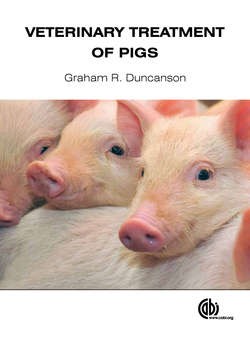Читать книгу Veterinary Treatment of Pigs - Graham R Duncanson - Страница 118
На сайте Литреса книга снята с продажи.
Single-handed post-mortem technique without a cradle
ОглавлениеThis is easiest if carried out in a series of steps.
1. Lie the pig on its left side and make a bold cut in the axilla, cutting all the skin and musculature so that the right front leg is totally reflected on to the ground.
2. Make a bold cut into the groin into the adductor muscles going straight into the hip joint and severing the ligament anchoring the femoral head into the acetabulum, so that right hind leg can be totally reflected (Fig. 3.3). The carcass should now be stable on its side.
3. Cut the skin from the opening around the hind leg along the ventral mid-line to the skin cut in the axilla (Fig. 3.4).
4. Cut the skin from this skin incision through the ventral mid-line, reflect the skin as a large flap to the spine so that it can be laid out behind the backbone as a flat surface with the skin on the ground. This can then be used to lay the internal organs on, rather than on the ground.
5. Cut the skin from the cranial point of the ventral skin incision, an incision should be made cranially to the symphysis of the mandibular rami.
6. Cut the skin from the caudal point of the ventral skin incision, an incision should be made caudally to the rectum/vulva.
Fig. 3.3. The upper and lower legs are reflected.
Fig. 3.4. The abdomen is opened.
7. The abdominal cavity should be opened carefully from the xiphisternum to the pubic symphysis. Samples can be taken from the peritoneal fluid and from the liver for bacteriology.
8. The abdominal musculature should be cut along the line of the last rib from the xiphisternum to the spine, so that the flank can be reflected and the internal organs revealed (Fig. 3.5). The liver will just be seen caudal to the xiphisternum with a small portion of the stomach. The rest of the abdomen will be filled with the greater omentum cranially and the jejunum caudally.
9. Two cuts should now be made through the diaphragm along both costalchondral junctions cranially and including the first ribs. In growing and fattening pigs these cuts can normally be carried out with a sharp postmortem knife. In adults a saw or a pair of garden loppers may be required. Then the whole sternum can be removed.
10. Multiple cuts should be made through the intercostal muscles between the ribs dorsally to the spine, so that each rib can be broken in a dorsal direction near to the spine. The heart, lungs and the rest of the thorax can then be examined in situ. Bacteriological samples can be taken at this stage. Heart blood can be aspirated.
Fig. 3.5. The liver, spleen, small and large bowel are visible.
11. A cut should be made between the mandibles so that the tongue can be grasped. It should be pulled using blunt dissection so that the whole ‘pluck’ can then be removed, i.e. the larynx, trachea, oesophagus, lungs and heart.
12. A cut at the caudal end of the oesophagus will remove the ‘pluck’ from the intestinal tract.
13. A cut should be made down both the trachea and the oesophagus to examine the internal mucosa.
14. The lungs, the mediastinal lymph nodes and the thymus should be examined carefully. The pericardium, the outside and the inside of the heart should be examined, paying particular attention to the heart valves.
15. The whole intestinal tract should be examined outside and inside. This should also include an examination of the liver, spleen, omentum and lymph nodes. The contents of the intestinal tract should be examined for nematodes and samples should be taken for bacteriology.
16. The rest of the carcass should be examined. This should include the adrenal glands, kidneys, ureters, bladder and urethra. Bacteriological samples can be taken at this stage. The uterus or male genital tract should also be examined. The contents of the bladder should be examined and a sterile sample should be taken if required.
